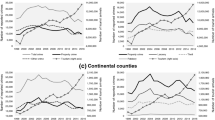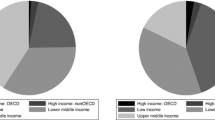Abstract
We examine the impact of hurricanes in Florida on county-level taxable sales revenues. Conditional on the strength of the hurricane, within 6 months after a hurricane strikes a county, revenues decline as much as 17 %, whereas revenues in neighboring counties increase by upward of 17 % over that same time frame. This decline in revenue is found to be dependent on the commercial makeup of a hurricane-stricken county. Particular focus is given to tourism-related subsectors within the local economy. Finally, we show that along the pathways of hurricanes, initially hit counties face a more severe burden, ranging as high as a 33 % immediate decline in taxable revenues in 1 month for coastal counties. As the hurricane weakens, the direct impact is lessened; however, there is evidence of spillover damage in neighboring areas.
Similar content being viewed by others
Notes
Unfortunately, data limitations prevent us from being able to examine the tourism sector as a whole.
Prior studies on hurricanes primarily used quarterly data and found significant results one quarter after the strike (i.e., between 4 and 6 months following the hurricane). With monthly data, we will be examining each of the 6 months after the strike. Xiao (2011) shows that local economies are relatively resilient and will bounce back shortly after a disaster strikes.
Note that five of the six most damaging Atlantic Hurricanes of all time struck Florida during this time period, as did some of the least damaging hurricanes. Therefore, this time period serves to provide a good mix of the potential economic disruption of hurricanes.
Note that when expanding the radius to 100 or 150 km the results in our analysis did not have a statistically significant change.
Note that in some months, the tax revenues were negative, reflecting months in which the State of Florida received a net tax loss because of adjustments due to overpayments in previous time periods. While the negative values are a relatively rare phenomenon, tax adjustments occur consistently throughout the data.
While overall sales tax rates differ by locality in Florida, the state government collects a flat 6 % rate across the entire state.
We do not include the hotel sector in our study of tourism-related subsectors. First, taxable sales by the hotel sector are combined with those by apartments and rooming houses, etc., in the data provided by the Florida Department of Revenue; second, the classification of this category was not consistent for the duration of our analysis.
Individuals in hurricane-stricken regions often report that the loss of electricity and other infrastructure damage often forces them to actually increase restaurant consumption relative to meals at home, but that they often are forced out to neighboring areas to find restaurants that were unaffected by the hurricane.
Note that the number of units per county diminishes greatly when examining the subsectors, and some subsectors are completely unreported by the BEBR for certain counties due to the sample size being so low that it would compromise privacy. Hence, the significance level is not nearly as high in these as in the overall examination. So, while the stronger hurricanes came up insignificantly, we attribute that to the smaller number of firms surveyed rather than to the actual impact of the hurricanes. Thus, the analysis in this section will focus only on the weaker hurricanes.
Note that these results may be swayed by Hurricane Andrew which only directly impacted Miami-Dade and Monroe counties before passing from the Atlantic Ocean into the Gulf of Mexico. The extreme devastation of Andrew may serve as an outlier for this particular form of analysis.
References
Belasen AR, Polachek SW (2008) How hurricanes affect wages and employment in local labor markets. Am Econ Rev 98(2):49–53
Belasen AR, Polachek SW (2009) How disasters affect local labor markets: the effects of hurricanes in Florida. J Hum Resour 44(1):251–276
Berry J (2002) Cooking trends in the United States: are we really becoming a fast food country? Energy Information Administration. http://www.eia.doe.gov/emeu/recs/cookingtrends/cooking.html
Cho S, Gordon P, Moore JE II, Richardson HW, Shinozuka M, Chang SE (2001) Integrating transportation network and regional economic models to estimate the costs of a large urban earthquake. J Reg Sci 41(1):39–65
Clukey L (2010) Transformative experiences for Hurricanes Katrina and Rita disaster volunteers. Disasters 34(3):644–656
Ewing BT, Kruse JB (2001) Hurricane Bertha and unemployment: a case study of Wilmington, NC. In: Proceedings of the Americas conference on wind engineering
Ewing BT, Kruse JB (2002) The impact of project impact on the Wilmington, NC labor market. Public Financ Rev 30(4):296–309
Ewing BT, Kruse JB, Thompson MA (2005) An empirical examination of the Corpus Christi unemployment rate and Hurricane Bret. Nat Hazards Rev 6:191–196
Ewing BT, Kruse JB, Thompson MA (2009) Twister! Employment responses to the May 3, 1999, Oklahoma City Tornado. Appl Econ 41(6):691–702
Guimaraes P, Hefner FL, Woodward DP (1993) Wealth and income effects of natural disasters: an econometric analysis of Hurricane Hugo. Rev Reg Stud 23:97–114
Hallegatte S, Boissonnade A, Schlumberger M, Muir-Wood R (2008) Demand surge and worker migrations in disaster aftermaths: application to Florida in 2004 and 2005. http://www.centre-cired.fr/IMG/pdf/Migration_Final.pdf
Kapucu N (2008) Collaborative emergency management: better community organizing, better public preparedness and response. Disasters 32(2):239–262
Kim Y, Kang J (2010) Communication, neighborhood belonging and household hurricane preparedness. Disasters 34(2):470–488
Rose A, Benavides J, Chang SE, Szczesniak P, Lim D (1997) The regional economic impact of an earthquake: direct and indirect effects of electricity lifeline disruptions. J Reg Sci 37(3):437–458
Rose A, Liao S (2005) Modeling regional economic resilience to disasters: a computable general equilibrium analysis of water service disruptions. J Reg Sci 45(1):75–112
Strobl E (2008) The economic growth impact of hurricanes: evidence from US coastal counties. IZA Discussion Paper No. 3619
Thacker MTF, Lee R, Sabogal RI, Henderson A (2008) Overview of deaths associated with natural events, United States, 1979–2004. Disasters 32(2):303–315
West C, Lenze D (1994) Modeling the regional impact of natural disaster and recovery. Int Reg Sci Rev 17(2):121–150
Xiao Y (2011) Local economic impacts of natural disasters. J Reg Sci 51(4):804–820
Xiao Y, Feser E (2013) The unemployment impact of the 1993 US midwest flood: a quasi-experimental structural break point analysis. Environ Hazards. doi:10.1080/17477891.2013.777892
Acknowledgments
The authors would like to thank Solomon Polachek, Sajal Lahiri, and seminar participants at SIU Carbondale, along with Jamie Kruse and seminar participants at the 77th Annual Southern Economic Conference for their comments and suggestions.
Author information
Authors and Affiliations
Corresponding author
Appendix
Appendix
See Tables 1, 2, 3, 4, 5, and 6.
Rights and permissions
About this article
Cite this article
Belasen, A.R., Dai, C. When oceans attack: assessing the impact of hurricanes on localized taxable sales. Ann Reg Sci 52, 325–342 (2014). https://doi.org/10.1007/s00168-013-0587-8
Received:
Accepted:
Published:
Issue Date:
DOI: https://doi.org/10.1007/s00168-013-0587-8




